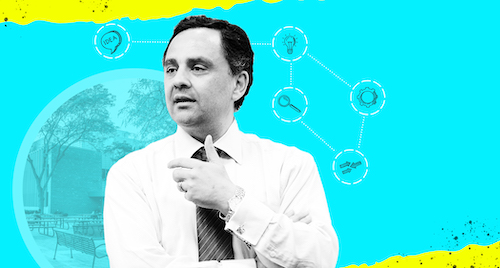
Professor Armen Zakarian has been part of the university community long enough to remember a time when research was still a tiny part of what happened at UM-Dearborn. “It’s hard to describe how much it’s changed,” he says. “I mean, there were times that, to get a master’s student to work on my research project, I’d have to co-sign the lease on their apartment or even let them stay at my house. We just didn’t have the infrastructure. Now, it’s a much different landscape.”
Today’s research environment, Zakarian says, bears many of the hallmarks of a quickly maturing enterprise. UM-Dearborn now boasts a growing number of Ph.D. programs and two dozen master’s programs — all of which he says are essential to helping researchers attract top grad students and pull off bigger projects. The impact of scholarly research has been steadily increasing. Faculty are securing larger awards and cultivating more consequential industry and community partnerships too. And the campus infrastructure to support research has significantly improved— both in terms of new labs and facilities, and the staff devoted to growing the university’s research footprint.
Now, as the newly appointed Vice Provost for Research (pending regential approval), Zakarian is charged with charting a course for the university’s next big growth spurt. And for him, that entails a great deal more focus on high-level interdisciplinary research. One of the main reasons is that research efforts that tackle big-picture problems, like mobility, urban development, public health and STEM education, are multidisciplinary by nature. Simply put, no one person or discipline is really equipped to solve problems as complex as the ones we face today. Moreover, Zakarian says funders are now heavily emphasizing research that’s not only technologically innovative, but also designed to be equitable and relevant to the communities where the solutions will be deployed.
“You can’t just develop ideas without understanding the impact on communities,” Zakarian says. “This has to be embedded deeply into your research program. And this is where I think we have a great opportunity to have folks who develop technologies and methods and models work alongside folks who do community-based research and outreach. They are the ones actually interfacing with the human environment where these ideas will be tested.”
So how do you get, say, engineers, environmental scientists, anthropologists and public health experts all working together on a single project? Zakarian says there are lots of ways to facilitate that kind of collaboration. Going after top-tier grants often requires multidisciplinary teams, so organizing efforts around specific high-profile funding opportunities can give folks from different disciplines a very concrete motivation for teaming up. Similarly, the university can make multidisciplinary work a condition of internal funding, analogous to how the MCubed program requires collaboration among a “cube” of three researchers from at least two different departments. Another key strategy: Leaning on young faculty to lead. He says UM-Dearborn has done a great job attracting top talent, and junior faculty are not only “immensely talented” but full of energy and inclined toward collaboration.
More fundamentally, Zakarian thinks one of his main challenges will be cultivating interpersonal skills that allow researchers to work together. It may sound simple, but he says patience and the ability to listen with an open mind are essential — and hard to master.
“I think many of us can relate to this, but when you have an area of expertise, and you encounter an idea you’re unfamiliar with, it can be very easy to dismiss it,” Zakarian says. “One of the ways you can get past that is to look for the interconnections. When you listen deeply, the interconnections are always there. Right now, I would say maybe it’s not all that common for our folks in different units to talk regularly with each other. Some do, but not many. So I think part of my role can be to help folks see the connections.”
Provost Sue Alcock said that Zakarian’s own interdisciplinary experiences give him a great foundation for that kind of approach. “Professor Zakarian's broad knowledge of the campus and its many disciplinary components will prove of critical importance to this position,” she said in a recent campus communication. “With work through the Human-Centered Design and Engineering degree, for example, he has collaborated with a range of faculty on campus, notably in the College of Arts, Sciences, and Letters. Given the increasingly interdisciplinary nature of truly original, path-breaking research today, growing our collaborative campus networks is essential to future success.”




